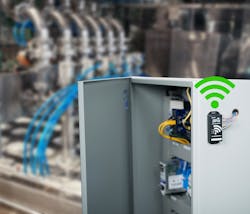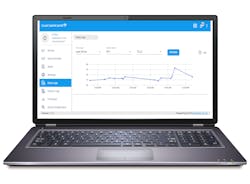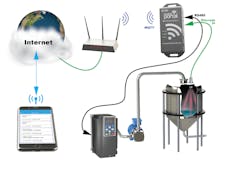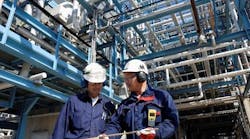Many industries operate equipment and systems that generate valuable data, but it often remains inaccessible and trapped within islands of automation due to physical remoteness or incompatible control platforms. In truth, by applying enough money, effort, hardware, software, networking, programming and configuration, it is possible to connect almost anything to anything else. But the reality is, there are many situations where end users want a simple way to collect and transmit the data from multivariable measurements.
The highest hurdle for many traditional data collection and transmission methods has been the amount of hardwiring required — whether in the form of signal cables, copper or fiber Ethernet or ordinary telephone cabling. To a great extent, Ethernet, Wi-Fi and cellular connections have overcome such issues.
Still, there needs to be some target device in the field capable of connecting to the signals generated by instruments and transmitting them to where they are needed. Oftentimes, there are just a few input/output (I/O) points of key interest, which may not warrant the complexity and expense of developing a complete connectivity solution from scratch, such as a programmable logic controller (PLC) or a supervisory control and data acquisition system (SCADA).
This article discusses how end users can easily take advantage of new portal devices that apply modern internet of things (IoT) concepts to connect to these measurement points, transmit them to the cloud, log the data, provide basic alarming functionality and make this information viewable by end users on mobile devices without the need to write any custom software code.
Many sources
Field I/O signals come in all sorts of flavors. Maybe there is a standalone analytical instrument sampling water or a temperature transmitter inside an equipment building or electrical powerhouse. Sometimes, a small control panel is hardwired with relays. In these cases, there is little or no local computing intelligence available to gather the signals and transmit them via a network connection.
In other cases, there are local dedicated controllers or more generalized PLCs that may be able to do the job. However, many end users do not have the licensing, available source code, software or training to access these devices and modify them to transmit data. Even if there are personnel technically capable of doing so, these same end users are often reluctant to modify or even touch an operational automation system that is actively in service.
For these reasons, a portal device should be considered because it can be added into new or existing systems with minimal effort and impact. These types of portal devices can connect to standalone components or be added to existing systems, and in either case, adding the ability to communicate measured values of multiple variables to higher level systems.
Smart portals simplify connectivity
To be considered for any industrial or commercial application, a multivariable measurement portal needs a few key features, such as:
- Built for challenging environments (temperature, dirt, vibration).
- Compact form factor for easy installation.
- Simple connectivity to I/O points.
- Support Modbus RTU. communications protocol
- Native Wi-Fi networking to internet cloud service.
- Standard data logging, notification, visualization and exporting capabilities.
The packaging of a portal may not be watertight, but it should be suitable for installation within industrial locations where it can join an existing Wi-Fi environment and access the internet. Sometimes, the portal may be installed open to the environment — especially if it is within an electrical or equipment room — but other times, it may need to be enclosed in a nonmetallic enclosure (as shown in Figure 1). Installing portals within metallic enclosures is generally not an option due to degradation of the Wi-Fi signal.
Portals need to be connectable to common instruments and signaling devices. The example device shown in Figure 1 can accept up to four hardwired low-voltage discrete (on/off) signals as inputs or outputs. It can therefore monitor limit switches or alarm contacts, or it can be configured to remotely turn other devices on or off. This portal can also monitor two analog inputs, which is ideal for data logging and trending temperature, pressure, flow, level and other measurements.
Because so many existing field devices and controllers support the standard Modbus RTU serial communication protocol, this portal is also configurable to connect with those devices. When using Modbus RTU, the portal can collect and transmit much more data — limited only to 100 tags and the data plan selected.
The cloud connection
A key feature for any portal device should be a nearly plug-and-play standard connection to a low-cost cloud service, which liberates users from the time and expense of creating their own networking, communication and software solution.
Once users first install the portal, a wireless Bluetooth connection and a mobile device app provide a quick and handy way to provision and configure the device locally, so the user can define the I/O connections, establish the Wi-Fi network information and marry the device to the proper cloud service.
Multi-tenancy allows users to connect and associate a portal to individual customers or other teams needing access to the device, while keeping each customer or team isolated from one another. This is extremely helpful for system integrators, machine builders or service companies supporting many different clients and locations requiring a variety of access needs.
Connected devices will automatically communicate I/O data to the cloud using MQTT, an industry-standard secure data messaging protocol. MQTT is a lightweight protocol optimized for communicating over remote and limited-bandwidth links. The portal and cloud solutions automatically provide all coordination required for the MQTT connections, so users do not need to manage this.
Lightweight portal solutions may log a nominal number of measurement points for free, with a small additional charge for greater numbers of points. Logging rates should be sufficient for most applications. Other benefits of a cloud-hosted service include user and device management and over-the-air updates, with cloud software support and maintenance/upgrades supplied by the provider.
Remote measurement applications
Many industries such as water and wastewater, chemical storage and power generation rely on numerous remote operational and utility sites. For instance, there is a common need to monitor fluid levels, which can be water, fuel or other process media. These systems are often associated with pumps that may provide running, pressure and flow indications. An end-to-end IoT solution with secure data collection, visualization and real-time alerts provides users with the tools to monitor and manage these and other types of remotely installed systems.
With a lightweight IoT system in place, users could realize the following benefits:
- Tank level recording for optimization and audit trail.
- Measure consumption over time.
- Detect leaks based on excess consumption.
- Avoid overflow or dry-run conditions.
- Reduce the amount of time that workers need to visit remote or hazardous areas.
This is just one example — with many more possibilities limited only by application needs and ideas for improvements.
Using the IoT anywhere
The difficulty and expense of monitoring multiple measurement points using traditional automation platforms and methods can discourage users from doing so. Installing one or more portals may be the best way for users to monitor a small number of signals in most any industrial setting, including both new systems and retrofits to existing equipment. This approach to multivariable measurement is now possible due to standard products and services based on contemporary hardware, software, networking, cloud computing and mobile technologies.
Bill Dehner is an automation specialist with AutomationDirect. He has spent the majority of his 15-year engineering career designing and installing industrial control systems for the oil and gas, power, and package handling industries. Dehner holds a bachelor’s degree in electrical engineering, with an associate degree in avionics from the USAF, and he is currently working for AutomationDirect as a technical marketing engineer.





